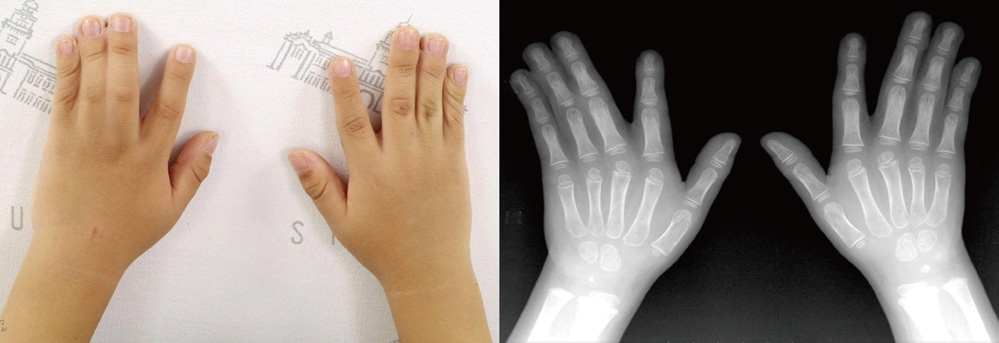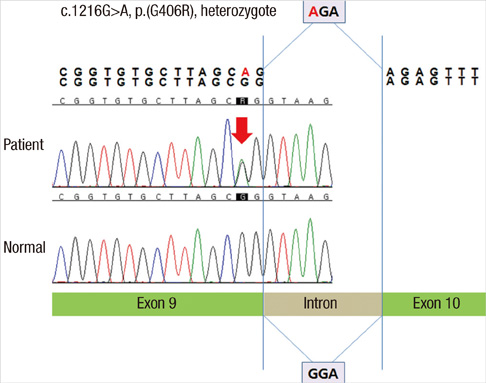J Korean Med Sci.
2013 May;28(5):788-791. 10.3346/jkms.2013.28.5.788.
Sudden Cardiac Arrest during Anesthesia in a 30-Month-Old Boy with Syndactyly: A Case of Genetically Proven Timothy Syndrome
- Affiliations
-
- 1Department of Pediatrics, Seoul National University Children's Hospital, Seoul, Korea. eunjbaek@snu.ac.kr
- 2Department of Laboratory Medicine, Seoul National University Children's Hospital, Seoul, Korea.
- KMID: 1777571
- DOI: http://doi.org/10.3346/jkms.2013.28.5.788
Abstract
- Timothy syndrome, long QT syndrome type 8, is highly malignant with ventricular tachyarrhythmia. A 30-month-old boy had sudden cardiac arrest during anesthesia induction before plastic surgery for bilateral cutaneous syndactyly. After successful resuscitation, prolonged QT interval (QTc, 0.58-0.60 sec) and T-wave alternans were found in his electrocardiogram. Starting beta-blocker to prevent further tachycardia and collapse event, then there were no more arrhythmic events. The genes KCNQ1, KCNH2, KCNE1 and 2, and SCN5A were negative for long QT syndrome. The mutation p.Gly406Arg was confirmed in CACNA1C, which maintains L-type calcium channel depolarization in the heart and other systems.
Keyword
MeSH Terms
-
Anesthesia/*adverse effects
Calcium Channels, L-Type/*genetics
Death, Sudden, Cardiac/*etiology
Electroencephalography
Humans
Infant
Long QT Syndrome/*genetics
Magnetic Resonance Imaging
Male
Methyl Ethers/adverse effects
Nitric Oxide/adverse effects
Polymorphism, Single Nucleotide
Sequence Analysis, DNA
Surgery, Plastic
Syndactyly/diagnosis/*genetics/surgery
Calcium Channels, L-Type
Methyl Ethers
Nitric Oxide
Figure
Reference
-
1. Splawski I, Timothy KW, Sharpe LM, Decher N, Kumar P, Bloise R, Napolitano C, Schwartz PJ, Joseph RM, Condouris K, et al. Ca(V)1.2 calcium channel dysfunction causes a multisystem disorder including arrhythmia and autism. Cell. 2004. 119:19–31.2. Splawski I, Timothy KW, Decher N, Kumar P, Sachse FB, Beggs AH, Sanguinetti MC, Keating MT. Severe arrhythmia disorder caused by cardiac L-type calcium channel mutations. Proc Natl Acad Sci U S A. 2005. 102:8089–8096.3. Lo-A-Njoe SM, Wilde AA, van Erven L, Blom NA. Syndactyly and long QT syndrome (CaV1.2 missense mutation G406R) is associated with hypertrophic cardiomyopathy. Heart Rhythm. 2005. 2:1365–1368.4. Splawski I, Timothy KW, Priori SG, Napolitano C, Bloise R. Pagon RA, Bird TD, Dolan CR, Stephens K, Adam MP, editors. Timothy syndrome. GeneReviews. accessed on 1 July 2012. Seattle: http://www.ncbi.nlm.nih.gov/books/NBK1403.5. Krause U, Gravenhorst V, Kriebel T, Ruschewski W, Paul T. A rare association of long QT syndrome and syndactyly: Timothy syndrome (LQT 8). Clin Res Cardiol. 2011. 100:1123–1127.6. Crotti L, Celano G, Dagradi F, Schwartz PJ. Congenital long QT syndrome. Orphanet J Rare Dis. 2008. 3:18.7. Gillis J, Burashnikov E, Antzelevitch C, Blaser S, Gross G, Turner L, Babul-Hirji R, Chitayat D. Long QT, syndactyly, joint contractures, stroke and novel CACNA1C mutation: expanding the spectrum of Timothy syndrome. Am J Med Genet A. 2012. 158A:182–187.8. Etheridge SP, Bowles NE, Arrington CB, Pilcher T, Rope A, Wilde AA, Alders M, Saarel EV, Tavernier R, Timothy KW, et al. Somatic mosaicism contributes to phenotypic variation in Timothy syndrome. Am J Med Genet A. 2011. 155A:2578–2583.9. Kies SJ, Pabelick CM, Hurley HA, White RD, Ackerman MJ. Anesthesia for patients with congenital long QT syndrome. Anesthesiology. 2005. 102:204–210.10. Nathan AT, Berkowitz DH, Montenegro LM, Nicolson SC, Vetter VL, Jobes DR. Implications of anesthesia in children with long QT syndrome. Anesth Analg. 2011. 112:1163–1168.11. Whyte SD, Sanatani S, Lim J, Booker PD. A comparison of the effect on dispersion of repolarization of age-adjusted MAC values of sevoflurane in children. Anesth Analg. 2007. 104:277–282.12. Marks ML, Whisler SL, Clericuzio C, Keating M. A new form of long QT syndrome associated with syndactyly. J Am Coll Cardiol. 1995. 25:59–64.13. Schwartz PJ, Priori SG, Cerrone M, Spazzolini C, Odero A, Napolitano C, Bloise R, De Ferrari GM, Klersy C, Moss AJ, et al. Left cardiac sympathetic denervation in the management of high-risk patients affected by the long-QT syndrome. Circulation. 2004. 109:1826–1833.
- Full Text Links
- Actions
-
Cited
- CITED
-
- Close
- Share
- Similar articles
-
- Cardiac Arrest under Anesthesia in a Child with Previously Undiagnosed Long QT Syndrome: A case report
- Cardiac Arrest during Tracheostomy Cannula Misplacement - A Case of Diphtheria
- A Sudden Cardiac Arrest during Spinal Anesthesia
- Cardiopulmonary arrest due to sick sinus syndrome: A case report
- Medullary Infarction Presenting as Sudden Cardiac Arrest: Report of Two Cases and Review of the Literature




